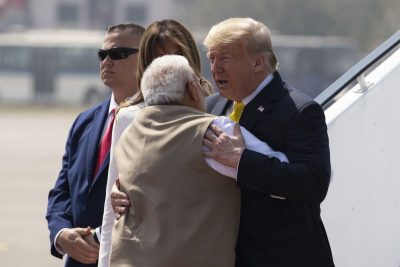Trump’s India Visit Was Aimed Against China but Produced No Results

During U.S. President Donald Trump’s visit to India on Monday and Tuesday, he was led to a packed cricket stadium with about 100,000 people in Ahmedabad, the capital of Gujarat, the home of Indian Prime Minister Narendra Modi. Although many viewed this visit from the trade perspective, we cannot overlook that this visit is also part of Trump’s hostilities with China. Due to the complex situation in Sino-U.S. relations, Trump went to India with intentions of encouraging the country’s leadership to participate in certain projects to undermine China. Although India is a potential competitor of China, India says it is adhering to a balanced policy despite its friction with China. With these frictions existing, it is still not enough to consider India an opponent of China.
Trump has not swayed India to be openly adversarial to China, however his intentions would have been to at least demonstrate that he has identified India into his umbrella of states to oppose China. The president’s visit took place in the hope of signing a trade agreement with India. In the end, both leaders did not agree on a much talked-about trade agreement where Trump was hoping to sign a deal that would help bridge the $25.2 billion trade deficit with India. Therefore, the U.S. still has aspirations and needs in this regard, but Washington is clearly unable to meet its needs.
This comes as the U.S. is currently facing the problem of a large number of job backflows and too many imports of Indian products will conflict with the domestic problems of the U.S. Although its domestic economy is facing difficulties, it is unlikely that India would want to become adversarial with China as the East Asian country is its second largest trading partner. India has to maintain its balanced policy with Beijing and Washington as it announced only days ago that the U.S. was once against India’s largest trading partner.
China’s growing influence is prompting the U.S. to more actively build its own Indo-Pacific strategy. Essentially, Washington is seeking partners to more actively restrict China as it rises in economic and military stature. But in the eyes of Trump, India is just a useful tool to implement this strategy and pressure China and its Belt and Road Initiative. India’s participation in the Indo-Pacific strategy was initially essential to oppose the Belt and Road Initiative. However, New Delhi hopes the Indo-Pacific strategy is an alternative to the Chinese Belt and Road Initiative and an opportunity for its own economic development independent of China in the hope of fulfilling its potential of becoming a Great Power on its own terms.
Initially India was enthusiastic for the U.S. strategy, this enthusiasm has now waned. India found that although it has common interests with the U.S. in balancing China, there were too many differences, especially revolving around trade. India’s current concern is not to curb China and other issues, but how to improve its domestic economy. Washington wants India to be a bridgehead in the region, however, India is currently governed by Hindutva nationalists, and they are very cautious with foreign ideologies, particularly those with an Anglo basis. In addition, the Indo-Pacific strategy does not have a known economic policy and structure as rather it is aimed at pressurizing China – a stark difference with the Belt and Road Initiative.
The constant threat of closing their markets and forcing India to buy something is not the best strategy to achieve results. In the political field, this is not the basis for long-term cooperation, especially if Trump wants India to be a bulwark against China. Trump did not sign any large-scale trade agreements during his visit while India needs a mutually beneficial trading partner like China. The problem remains unresolved, and there are too many trade gaps, making it difficult to make up for even with the expected use of military transactions. Although Trump did not explicitly mention China during his trip to India, he did indirectly mention China.
“During our visit we discussed the importance of a secure 5G wireless network and the need for this emerging technology to be a tool for freedom, progress, prosperity, not to do anything with where it could be even conceived as a conduit for suppression and censorship,” Trump said in a press briefing after his meeting with Modi. Trump has been urging countries not to use 5G equipment from China’s Huawei telecommunications company on the unfounded allegations that it could be used to spy on other countries, something that Huawei has repeatedly denied.
So, there is little doubt that Trump visited India hoping to consolidate and strengthen the country as part of his anti-China bloc, something that never eventuated in India’s approaching significantly closer to the U.S.
*
Note to readers: please click the share buttons above or below. Forward this article to your email lists. Crosspost on your blog site, internet forums. etc.
This article was originally published on InfoBrics.
Paul Antonopoulos is a Research Fellow at the Center for Syncretic Studies.

